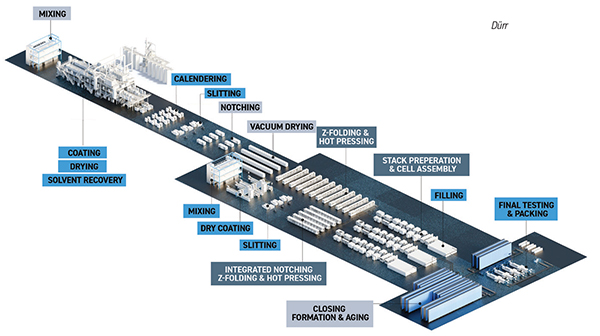The market for lithium-ion batteries continues to grow, driven by demands for consumer electronics, renewable energy storage and electric vehicles. The manufacture of these batteries is itself energy-intensive, with production steps that typically involve creating a slurry for a wet-coating step, followed by drying and subsequent solvent recovery. Last month at the Battery Show Europe in Stuttgart, Germany, Dürr AG (Bietigheim-Bissingen, Germany; www.durr.com) and GROB (Mindelheim, Germany; www.grobgroup.com) unveiled their new process concept (diagram) that uses a dry-coating operation, which eliminates the need for drying and solvent-recovery steps.

The Activated Dry Electrode® process uses a dry-mixed active material. This dry mixture is pressed into a free-standing film using calender machines, and the film is then laminated onto both sides of the collector foil. This dry-coating eliminates the drying process that is needed after wet-coating, as well as the recovery and treatment of solvents, thus saving space and energy use, according to Dürr.
Excess film from the free-standing film can be returned to the production process before lamination onto the collector foil. This improves efficiency in material usage. After calendering, the coat weight can be measured directly, enabling better control of the coating thickness. Another advantage is that the subsequent lamination onto the collector foil requires less force than calendering in the wet-coating process, which prevents the foil from deforming and improves its processability for downstream notching and stacking.
The two companies, which have been working together since 2022, also unveiled several additional technologies for improving Li-ion battery production. A new generation of Z-folders integrates the notching process to achieve high performance in less space. Using electrolyte filling pressures that are two to three times higher than the current standard shortens the filling process as well as the subsequent penetration of the electrolyte into the active material. The new technologies from Dürr and GROB are said to reduce space and energy consumption in battery cell production by 50%, according to the two companies.